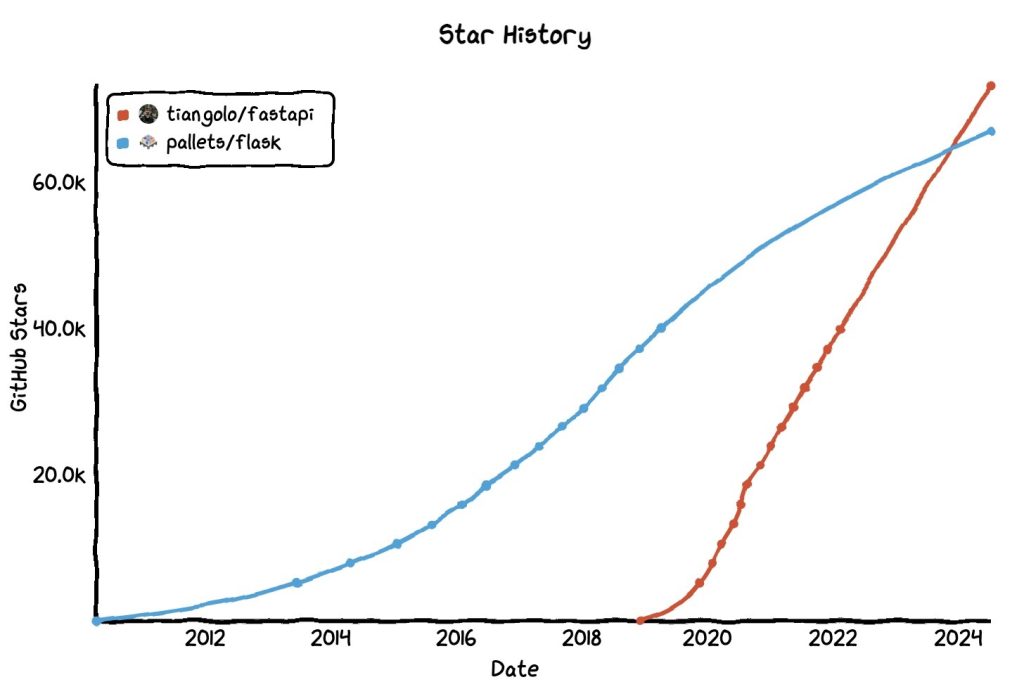How to Choose from the Top Backend Frameworks in 2025
Node.js vs FastAPI 2025 is one of the most discussed backend comparisons for developers building scalable web apps.
Node.js vs FastAPI 2025
In 2025, choosing the right backend framework is crucial for modern software development.
As a result, developers are increasingly focused on scalability and speed. With new trends emerging in speed, scalability, and security, developers are searching for the top backend frameworks in 2025. In this blog, we’ll explore the most powerful options—from Node.js to Spring Boot—and why they matter for your next project.According to Stack Overflow Developer Survey 2024, Node.js remains a top choice among backend developers.
The backend has always been the unseen force underlying all smooth online interactions. Backend frameworks control the scalability, security, and performance of any digital product, from user authentication to database queries and API management. The need for backend solutions that are scalable, maintainable, and high-performing is only going to increase as 2025 approaches. Selecting the appropriate backend framework can have a big impact on your development time and product success, whether you’re creating full-stack apps, RESTful APIs, or microservices.
As backend technology innovation picks up speed, new frameworks emerge and existing ones adapt to contemporary needs. Let’s examine the best backend frameworks for developers to become proficient in by 2025 and compare how well they operate in practical applications.
Top Backend Frameworks to Use in 2025: Detailed Comparison
🧠 Node.js vs FastAPI 2025: Which One Performs Better?
🔄 Node.js vs FastAPI 2025: Overview
Node.js is a JavaScript runtime environment built on Chrome’s V8 engine. Known for its event-driven, non-blocking I/O model, Node.js remains a preferred choice for real-time applications.
FastAPI, on the other hand, is a modern web framework written in Python. It is known for its fast performance, asynchronous support, and automatic API documentation generation.
Pros and Cons of Node.js vs FastAPI 2025
In 2025, comparing Node.js vs FastAPI 2025 is essential for backend developers looking to balance speed, scalability, and efficiency. This article explores the major pros and cons of both frameworks, helping you make an informed development choice.
⚙️ Node.js vs FastAPI 2025: Performance Comparison
Node.js:
- Optimized for I/O-heavy and real-time applications.
- Performs well in handling simultaneous requests.
- May lag slightly with CPU-bound operations.
FastAPI:
- Uses ASGI and Starlette for async capability.
- Outperforms older Python frameworks like Flask.
- Ideal for microservices and high-speed REST APIs.
Verdict: For asynchronous APIs, FastAPI wins. For real-time apps, Node.js is better.
🧑💻 Developer Experience with Node.js vs FastAPI 2025
Node.js:
- Massive npm library ecosystem.
- Unified frontend-backend JS stack.
- Can suffer from callback hell without async/await or Promises.
FastAPI:
- Clean syntax using Python type hints.
- Auto-generated Swagger UI docs.
- Easy to learn for Python developers.
Verdict: FastAPI is more intuitive for API development. Node.js offers broader ecosystem access.
📈 Node.js vs FastAPI 2025 Scalability & Deployment
Node.js:
- Scalable with clustering and microservices support.
- Widely used in cloud-native apps.
FastAPI:
- Container-friendly; works well with Docker & Kubernetes.
- ASGI-based design improves concurrency.
Verdict: Both scale well. Choose based on ecosystem and developer preference.
🌐 Node.js vs FastAPI 2025 Ecosystem & Community Support
Node.js:
- Vast community with years of maturity.
- Millions of npm packages.
FastAPI:
- Growing rapidly in the Python ecosystem.
- Backed by solid community and active GitHub contributors.
Verdict: Node.js has a larger, more mature ecosystem. FastAPI is catching up fast.
⚡ Node.js vs FastAPI 2025 Use Cases
Node.js:
- Real-time chat apps, multiplayer games
- Collaboration platforms
- Scalable streaming services
FastAPI:
- AI/ML model deployment APIs
- Internal enterprise tools
- Fast, secure data-driven APIs
✅ Final Verdict: Node.js vs FastAPI 2025
Choose Node.js if:
- You want full-stack JavaScript development.
- You need high-speed real-time interaction.
- You rely heavily on npm modules.
Choose FastAPI if:
- You prefer Python for backend and AI integration.
- You want fast API development with auto-docs.
- You need efficient async performance for APIs
1. JavaScript Power on the Server with Node.js
The backend landscape is still dominated by Node.js because of its extensive ecosystem and asynchronous, non-blocking architecture.

Let’s start with the most widely adopted backend runtime—Node.js.
Why Node.js Will Still Be Useful in 2025:
- Because of this, Node.js is ideal for real-time apps like chats and games.
- More than 1.3 million libraries are available for almost any backend task using the npm package manager.
- It is perfect for chat apps, streaming services, and REST APIs because of its event-driven architecture.
Common Use Cases:
- Dashboards in real time
- Backends for IoT
- Scalable e-commerce REST APIs
2. Python’s FastAPI: A Contemporary, Quick (High-Performance) Web Framework
Next, let’s dive into a high-speed Python framework: FastAPI.
Furthermore, FastAPI is rapidly becoming popular due to its speed and async capabilities.

Chart showing top backend frameworks in 2025 like Node.js and FastAPI
Why FastAPI Is Revolutionary:
- Use Python type hints to generate API documentation automatically (Swagger UI).
- Utilizing async/await for asynchronous support enhances speed and concurrency.
- Incredibly developer-friendly and boilerplate-free.
Examples of Use:
- Deployment of data science and machine learning models
- Architecture of microservices
- Automation of internal APIs
3. Spring Boot—Enterprise-Grade Java Framework
In contrast to Python and JavaScript, Java remains a strong enterprise choice thanks to Spring Boot.
Therefore, Java isn’t going anywhere—and Spring Boot is still widely used.
Why Businesses Rely on Spring Boot:
- Configuration is made easier with production-ready settings.
- Microservices are supported by Spring Cloud by default.
- Strong security and dependency management through Maven/Gradle.
Typical Use Cases:
- Finance and technology
- Platforms for enterprise SaaS
- Safe RESTful APIs
4. Django—Batteries-Included Python Framework
Another Python-based option that developers still love is Django.
For developers who wish to work quickly and create strong backend logic, Django provides a scalable, secure, and reliable solution.
The Persistent Domination of Django:
- Integrated admin panel, form processing, user authentication, and ORM.
- Promotes quick development while adhering to secure code guidelines.
- Works well with projects that require reusable, structured components.
Perfect For:
- CMS systems
- Applications for social networking
- Health and government websites
5. Express.js: The Compact and Adaptable Node.js Structure
Express.js serves as the framework that forms Node.js, if it is the engine.

On the other hand, Express.js offers a minimalist and flexible Node.js approach.
The Reasons Developers Adore Express:
- Minimalistic style that permits flexibility in the organization of apps.
- Large middleware ecosystem and community.
- Ideal for developing single-page applications (SPAs) and APIs.
Examples of Use:
- Backends for RESTful APIs
- Server-side rendering with frameworks like React or Vue
- Quick MVPs
6. Laravel—The Elegant PHP Framework
Similarly, Laravel continues to lead in the PHP space with its elegant syntax.
One of the most advanced and safest frameworks for PHP development in 2025 is Laravel.
The Reasons Laravel Is Still Effective:
- Elegant syntax, integrated ORM (Eloquent), and Artisan CLI tools.
- Strong community support and extensive official packages.
- Ideal for both monolithic and API-based apps.
Ideal For:
- Platforms for small to medium-sized websites
- API development with Passport or Sanctum
- Blade templates are used in SaaS products.
7. Microsoft’s Cross-Platform Framework, .NET Core
Finally, let’s take a look at Microsoft’s enterprise-ready framework: .NET Core.
One of the best options for cross-platform, high-performance backend development is still .NET Core (now simply .NET).
The Reasons It’s a Favorite of Companies:
- Cross-platform (Windows, Linux, and macOS)
- Razor Pages, Blazor, and Web API support
- Microsoft-backed and consistently tailored to business requirements
Uses:
- ERP programs
- Development of CRM
- Azure-based cloud-native apps
Tips for Selecting the Best Backend Framework in 2025
When deciding, always consider your team’s language proficiency.
In addition, weigh performance and community support.
Here are some things to think about:
- Language Proficiency: Focus on your team’s strengths, such as Python, Java, JS, etc.
- Performance Requirements FastAPI or Node.js may be better for really fast APIs.
- Project Scope: Small MVPs may benefit from Express or Laravel; large apps may need Spring Boot or .NET.
- Community & Ecosystem: A vibrant community translates into more support, guides, and plugins.
- No framework is one-size-fits-all—but choosing the correct one may drastically speed up development and enhance your application’s scalability and performance.
Final Thoughts: Backend in 2025 is All About Speed, Flexibility & Integration
Choosing from the top backend frameworks in 2025 will ensure better performance, easier scaling, and developer efficiency. By 2025, By 2025, the backend will facilitate smooth integration of AI, real-time systems, and more.
To sum up, choosing the right framework affects your entire development strategy.
Make an informed decision and allow your backend to be the unseen engine driving your next big idea.
Want to explore how these backend frameworks support modern software trends?
👉 Check out our guide on Functional Programming in Modern Dev Stacks

